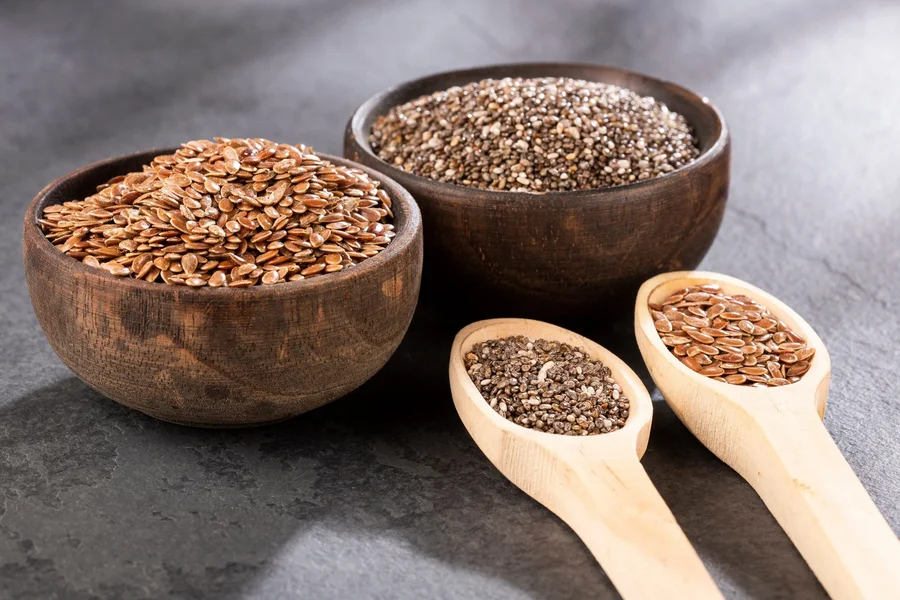Chia seeds and flax seeds have been around forever and to some extent have become popular again for their nutritional properties and versatility in adding them to your foods. But, for a lot of people, they are both interested in chia seeds and have maybe heard of flax seeds as well but are confused about how they are supposed to be used in recipes and what the difference is between chia seeds and flax seeds. Nutritional Content Similarly: In this blog post, we are going to learn the differences between chia seeds and flax seeds in the diet.
What are Chia Seeds?
The chia plant (Salvia hispanica) is native to Mexico and chia seeds have long since been a staple food of the Aztec and Mayan civilizations. In fact, chia seeds have been used in Aztec and Mayan diets despite being ancient staples, as well as for their medicinal purposes. Even today Chia seeds are popular because of their exceptional nutritional profile and ability to form a gel-like consistency when mixed with water.
Nutrient Richness:
Chia seeds are high in fiber, protein, and omega-3 fatty acids. They are also a great source of other micronutrients such as calcium, magnesium, and iron. Chia seeds are ever so slightly higher in fiber and protein than flax seeds. Chia seeds are full of omega-3 fatty acids which are rich in alpha-linolenic acid (ALA). ALA is a very important omega-3 which is linked to a lot of health benefits like inflammation reduction and heart health improvement.
Flavor and Texture:
When chia seeds are dry, they have a lovely crunch and are best described as having a light nutty flavor. When hydrated in water or some other fluid they form a thick gel and can be utilized to thicken a recipe.
How to Use Chia Seeds:
Chia seeds can be used in a number of ways including:
- Sprinkled on top of yogurt, oatmeal, or smoothie bowls
- Mixed into muffin, pancake, or bread batter
- As an egg replacer in vegan baking (combine 1 tablespoon of chia seeds and 3 tablespoons of water, and let sit 5 minutes to thicken)
- Mixed into salad dressings to thicken
- Used in meatballs or meatloaf as a replacement for breadcrumbs
What are Flax Seeds?
Flax seeds are harvested from the plant Linum usitatissimum and were originally from the Middle East. They have been used for thousands of years for their medicinal and culinary purposes.
Nutritional Content:
Flax seeds and ground flax are also loaded with fiber, protein, and omega-3 fatty acids. Lignans are plant compounds that have antioxidant properties. Flax seeds have slightly less fiber and protein in comparison to chia seeds.
Omega-3 Fatty Acids:
Flax seeds contain both ALA and lignan-derived enterolactone, which has important benefits for health.
Flavor and Texture:
They taste nuttier and crunchier than chia seeds. Non-gelling — they don’t become jelly when soaked.
How to Add Flax:
- Put ground flax in smoothies, yogurt, or oatmeal
- Mix ground flax in muffins, pancakes, or bread
- Sprinkle flax seeds on salads or roasted veggies
- Use ground flaxseed to help binding in veggie burgers or meatballs
- Replace eggs in baking with ground flaxseed (1 tablespoon ground flax + 3 tablespoons water – let sit for 5 minutes to thicken)
Nutrition Facts of Chia seeds and flax seeds
| Nutrient | Chia Seeds (1 oz/28g) | Flax Seeds (1 oz/28g) |
|---|---|---|
| Calories | 138 | 151 |
| Total Fat | 9 g | 12 g |
| Saturated Fat | 1 g | 1 g |
| Monounsaturated Fat | 1 g | 2 g |
| Polyunsaturated Fat | 7 g | 8 g |
| Omega-3 Fatty Acids (ALA) | 4,915 mg | 6,388 mg |
| Fiber | 11 g | 8 g |
| Protein | 4 g | 5 g |
| Calcium | 177 mg | 75 mg |
| Iron | 2.1 mg | 1.6 mg |
| Magnesium | 95 mg | 79 mg |
| Potassium | 115 mg | 160 mg |
Benefits of Flax Seeds Vs. Chia Seeds
Flax seeds and chia seeds are both tiny nutritional powerhouses that offer numerous health benefits. Here are some of the benefits of these two seeds, and how they compare to each other.
1. Protect Against Certain Cancers
Both flax seeds and chia seeds are rich in lignans, a type of phytoestrogen that has been shown to have anti-cancer properties. In particular, studies have found that lignans may help protect against breast and prostate cancers.
However, flax seeds are a better source of lignans than chia seeds, containing up to 800 times more lignans per gram than other plant foods. This means that flax seeds may offer stronger cancer-protective benefits than chia seeds.
Also read: A Coffee a Day Keeps Liver Cancer Away?
2. Help Lower Risk for Heart Disease
Both flax seeds and chia seeds are rich in omega-3 fatty acids, which have been shown to help reduce inflammation and lower the risk of heart disease.
In one study, consuming flax seeds daily for three months was found to reduce blood pressure and lower levels of LDL (bad) cholesterol in participants with high blood pressure. Similarly, chia seeds have been shown to improve various heart disease risk factors, such as reducing blood pressure and triglyceride levels.
While both seeds offer cardiovascular benefits, flax seeds are a slightly better source of omega-3s than chia seeds, containing more than twice as much of these beneficial fatty acids.
3. Help Lower Blood Sugar
Both flax seeds and chia seeds may help regulate blood sugar levels in people with type 2 diabetes.
In one study, consuming flaxseed powder for 12 weeks was found to improve fasting blood sugar levels and insulin resistance in participants with type 2 diabetes. Similarly, chia seeds have been shown to improve blood sugar control and insulin sensitivity in people with type 2 diabetes.
However, chia seeds may be a slightly better choice for blood sugar control than flax seeds, as they have a lower glycemic index and are less likely to cause spikes in blood sugar levels.
4. Curb Hunger and Appetite
Both flax seeds and chia seeds are high in fiber, which can help promote feelings of fullness and reduce appetite.
In one study, adding flax seeds to a beverage was found to significantly reduce hunger and increase feelings of fullness in participants. Similarly, consuming chia seeds has been shown to reduce appetite and food intake in healthy individuals.
While both seeds can help curb hunger and promote weight loss, chia seeds may be a slightly better choice for appetite control, as they contain more soluble fiber than flax seeds.
5. Improve Digestion
Both flax seeds and chia seeds are good sources of soluble fiber, which can help promote healthy digestion and prevent constipation.
In one study, consuming flaxseed flour was found to improve bowel movements and reduce constipation symptoms in participants with chronic constipation. Similarly, chia seeds have been shown to increase stool frequency and improve stool consistency in people with constipation.
While both seeds offer digestive benefits, chia seeds may be a slightly better choice for promoting regularity and preventing constipation, as they contain more soluble fiber than flax seeds.
6. Improve Brain Health
Both flax seeds and chia seeds are rich in omega-3 fatty acids, which are important for brain health and function.
In one study, consuming flaxseed oil was found to improve cognitive function and reduce inflammation in healthy older adults. Similarly, chia seeds have been shown to improve cognitive function and reduce brain inflammation in animal studies.
While both seeds offer brain-boosting benefits, flax seeds may be a slightly better choice for brain health than chia seeds, as they contain more alpha-linolenic acid (ALA), a type of omega-3 fatty acid that has been linked to improved cognitive function.
Chia Seeds Vs. Flax Seeds: How To Use & Eat
Chia seeds and flax seeds are two of the most popular superfoods that offer various health benefits. If you’re not sure how to use them, don’t worry, because there are plenty of ways to incorporate them into your diet. In this article, we’ll discuss the differences between chia seeds and flax seeds and how you can use them in different ways.
1. Ground The Seeds
Both chia seeds and flax seeds can be ground to a fine powder and added to your favorite recipes. Ground seeds are easier to digest and can be easily added to your meals. You can use a coffee grinder or food processor to grind the seeds. You can also buy pre-ground seeds from the store.
3. Sprinkle in Oatmeal
One of the easiest ways to incorporate chia and flax seeds into your diet is by sprinkling them into your oatmeal. Simply add a tablespoon of chia or flax seeds to your bowl of oatmeal and mix well. This will add some texture and crunch to your oatmeal, as well as provide some added nutritional value.
3. Add to Smoothies
Another great way to incorporate chia and flax seeds into your diet is by adding them to your smoothies. Simply add a tablespoon of chia or flax seeds to your favorite smoothie recipe before blending. This will add some fiber and protein to your smoothie, making it more filling and satisfying.
4. Sprinkle on Salad
Adding chia and flax seeds to your salad is an easy and delicious way to get some extra nutrients into your diet. Simply sprinkle a tablespoon of seeds over your salad before serving. This will add some crunch and texture to your salad, as well as provide some added nutritional value.
5. Make Chia Seed Pudding
Chia seed pudding is a popular and healthy breakfast or dessert option that is very easy to make. Simply mix together chia seeds, milk, sweetener, and any additional flavorings you desire, and let the mixture sit in the fridge overnight. In the morning, you’ll have a delicious and nutritious pudding that is high in fiber and protein.
6. Make Chia Seed Water
Chia seed water is another easy and healthy way to incorporate chia seeds into your diet. Simply add a tablespoon of chia seeds to a glass of water and let it sit for about 15 minutes. The seeds will form a gel-like substance that you can drink, providing you with some extra fiber and protein.
With these tips and ideas, you can easily incorporate chia seeds and flax seeds into your daily diet. Remember to start with small amounts and gradually increase intake to avoid digestive issues. Enjoy the benefits of these superfoods and experiment with new ways to use them in your meals and snacks!
Also read: 10 Natural Home Remedies for Glowing Skin
What chia seeds and flaxseeds taste like
Chia seeds are known for their neutral flavor, making them a popular choice for adding extra protein or antioxidants to dishes without affecting the taste. According to Jenna Gorham, RD, a registered dietitian and licensed nutritionist, chia seeds have a mild taste that may be hardly noticeable, but their small size and gel-like texture can add some interesting textures to your food.
Flaxseeds, on the other hand, have a slightly nutty flavor that can enhance the taste of dishes. As Jennifer Bravo, a recipe developer, intuitive eating coach, and food photographer, points out, you may not detect much flavor when eating whole flaxseeds, but they should not taste bitter or metallic. If they do, it’s a sign that they have gone rancid and should be discarded.
FAQ
Both chia and flax seeds are excellent sources of fiber, omega-3 fatty acids, and antioxidants. However, chia seeds have a milder flavor and can be eaten whole, whereas flax seeds have a stronger flavor and need to be ground before eating. Chia seeds also contain slightly more fiber and protein than flax seeds.
Both chia and flax seeds can aid in weight loss as they are high in fiber and low in calories. However, chia seeds may be slightly more effective in promoting satiety due to their ability to absorb water and expand in the stomach.
Yes, you can eat both chia and flax seeds raw, but it’s recommended to soak or grind them for better digestion and nutrient absorption. Flax seeds must be ground before consumption as our bodies cannot break down the hard outer shell.
It’s recommended to consume up to 1-2 tablespoons of chia or flax seeds per day, as they are high in fiber and can cause digestive issues if consumed in large amounts.
Generally, chia and flax seeds are safe for most people to consume. However, people with digestive disorders, such as inflammatory bowel disease, should consult their doctor before adding them to their diet.
Yes, chia and flax seeds are good sources of plant-based protein. However, they are not considered a complete protein as they do not contain all essential amino acids.
Conclusion
Chia seeds and flax seeds are both nutrient-dense and versatile foods that can be incorporated into a healthy diet. While they have some differences in nutritional content and taste, they can both be used in a variety of ways in cooking and baking. Whether you prefer the gel-like consistency of chia seeds or the crunch of flax seeds, there are plenty of ways to use both in your daily meals and snacks.
It’s worth noting that both chia and flax seeds are high in fiber, which can have some digestive benefits but may also cause discomfort in some individuals if consumed in excess. It’s important to start with small amounts and gradually increase intake to avoid digestive issues.
In summary, chia seeds and flax seeds are both nutritious and delicious additions to a healthy diet. They have some differences in nutritional content, taste, and culinary uses, but can be used interchangeably in many recipes. Whether you’re looking to add some crunch to your salads or thicken your smoothies, chia and flax seeds are a great way to boost the nutrition of your meals.
Sources
At WeeklyWoo, we follow rigorous procurement guidelines and rely on sources such as peer-reviewed studies, academic research institutes, and medical associations. Our primary focus is on peer-reviewed studies to ensure the information we provide is accurate and reliable. We avoid using tertiary references wherever possible. To learn more about our editorial process and how we maintain the accuracy and timeliness of our content, please refer to our guidelines.
- “Chia Seeds: Health Benefits, Uses, Side Effects, Dosage & Interactions.” RxList, Accessed 22 April 2023, https://www.rxlist.com/chia/supplements.htm.
- “Flaxseed and Flaxseed Oil.” National Center for Complementary and Integrative Health, U.S. Department of Health and Human Services, Accessed 22 April 2023, https://www.nccih.nih.gov/health/flaxseed-and-flaxseed-oil.
- “Chia Seeds vs Flax Seeds: Which Is Healthier?” Healthline, Accessed 22 April 2023, https://www.healthline.com/nutrition/chia-seeds-vs-flax-seeds.
- “10 Ways to Eat Chia Seeds.” EatingWell, Accessed 22 April 2023, https://www.eatingwell.com/article/288762/10-ways-to-eat-chia-seeds/.
- “7 Ways to Eat Flaxseed.” EatingWell, Accessed 22 April 2023, https://www.eatingwell.com/article/287670/7-ways-to-eat-flaxseed/.
- “Chia Seeds and Flaxseeds: Nutrition, Benefits, and Uses.” Medical News Today, Accessed 22 April 2023, https://www.medicalnewstoday.com/articles/291334.
- “Flaxseeds: Health Benefits, Tips, and Recipes.” Health, Accessed 22 April 2023, https://www.health.com/food/flaxseed-health-benefits-tips-and-recipes.
Keep in mind that the nutritional content can vary depending on the brand and type of chia seeds or flax seeds.






1 Comment